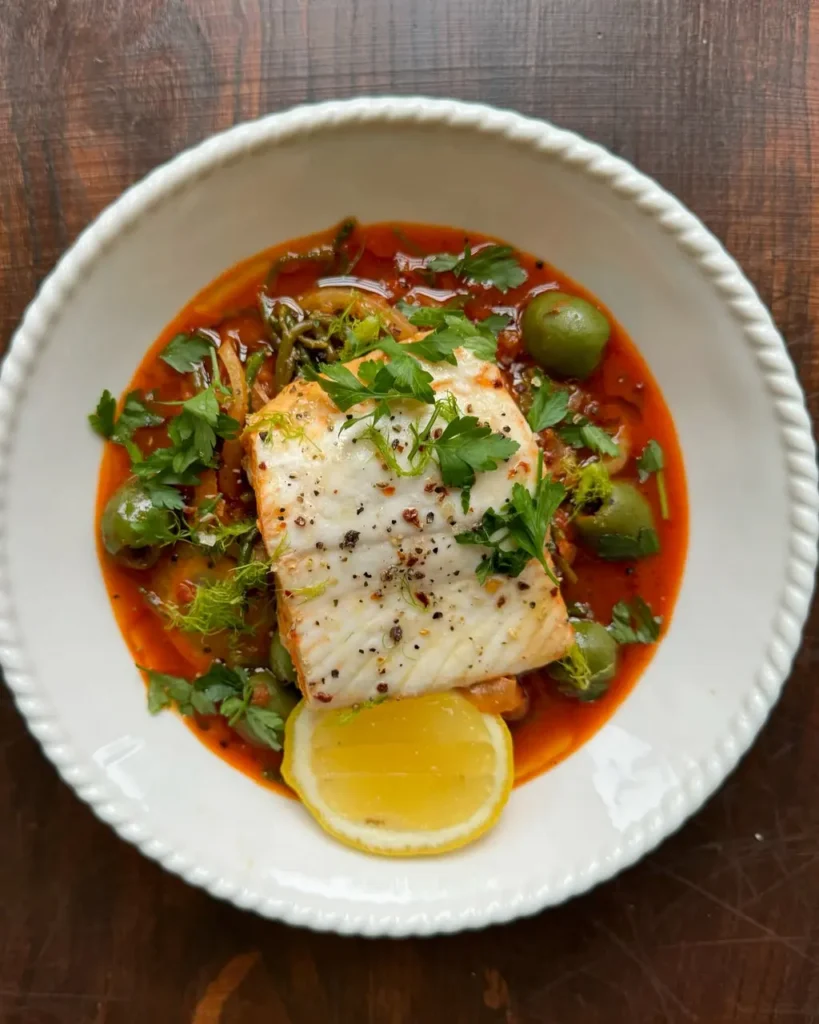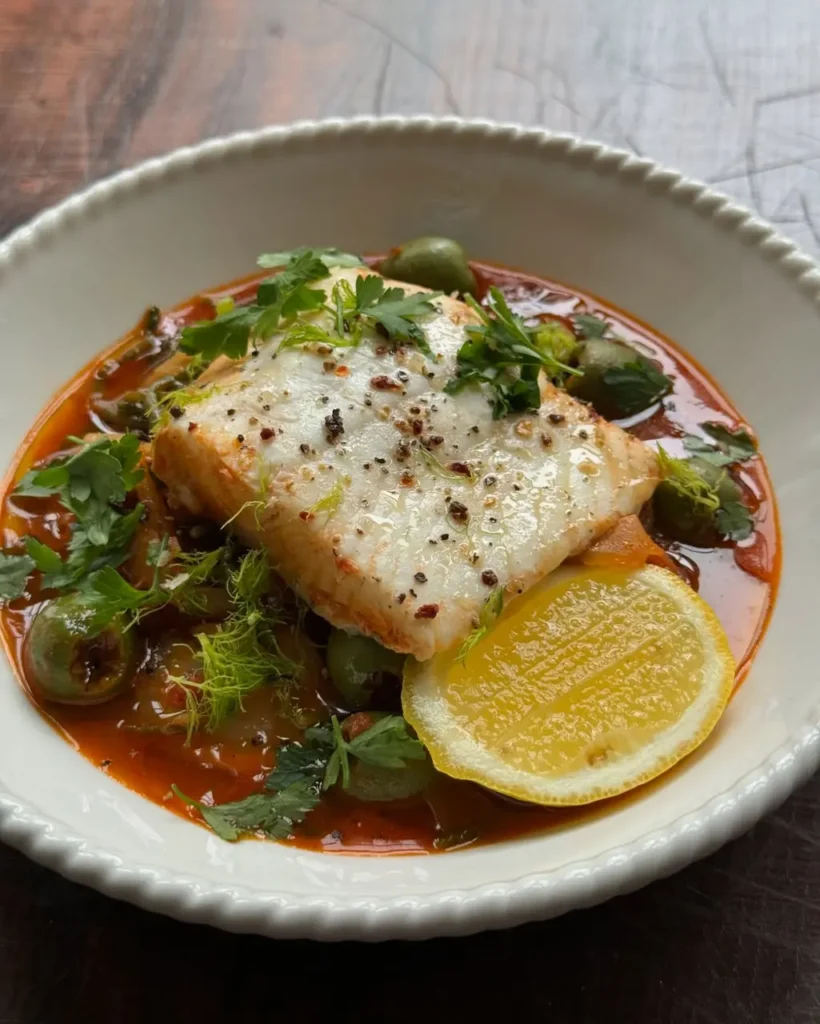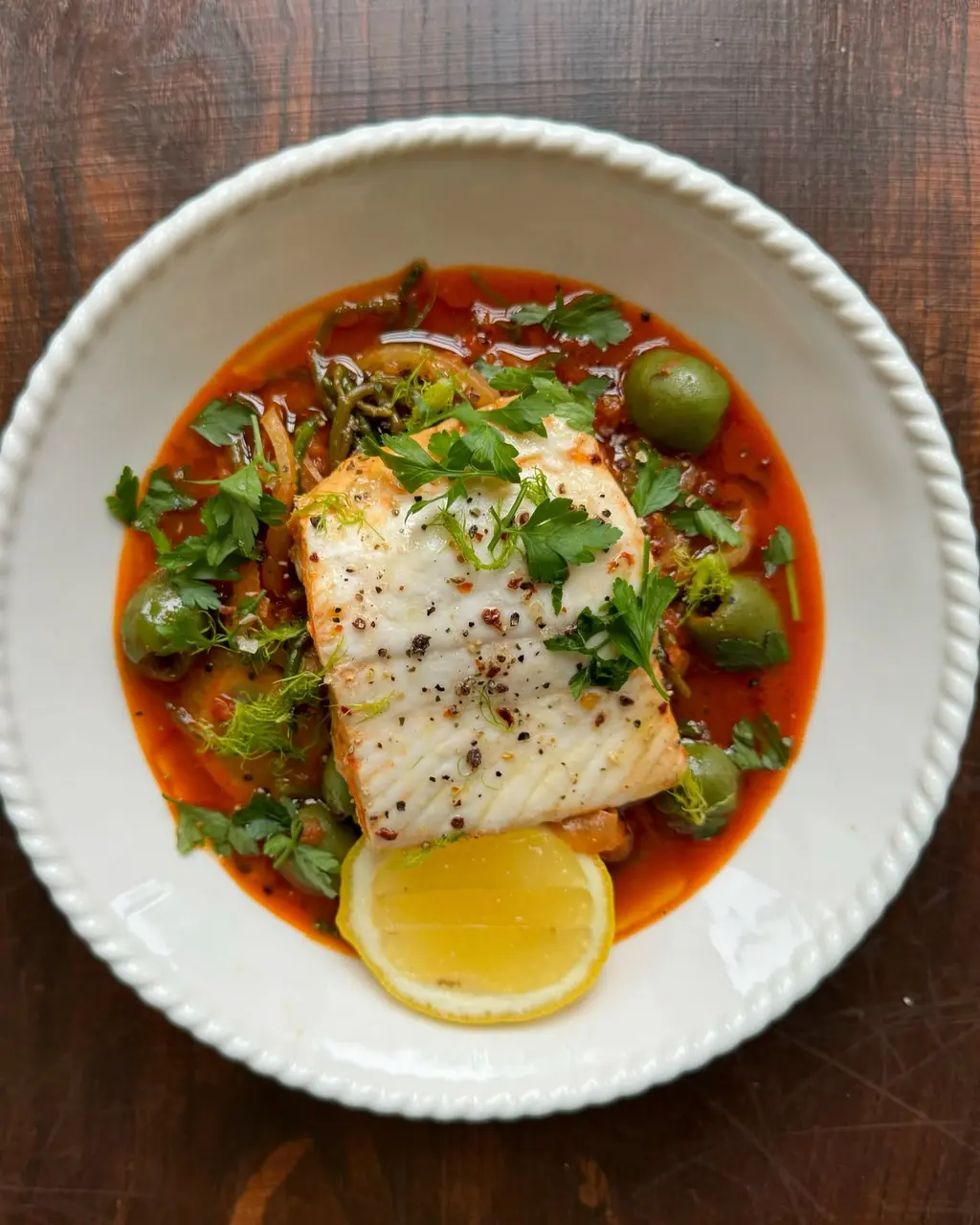Ready in under an hour, this halibut and potted shrimp stew is a bright, one-pot dinner that feels both rustic and refined.
The briny samphire, aniseed fennel, and meaty olives build a savory broth that gently poaches flaky halibut into tender perfection.
Why this stew is a weeknight winner

This recipe balances bold, salty flavors with clean, fresh aromatics for a dish that’s impressive but truly simple to pull together.
You’ll spend most of the time simmering a flavorful liquid and letting the fish finish gently, which keeps hands-on effort minimal.
What you’ll need (for 2 people)
The ingredients are straightforward and pantry-friendly, anchored by halibut fillets, potted shrimp, and a tin of tomatoes.
You’ll also want fennel for its crunchy, licorice notes, samphire for a pop of seaside saltiness, and Nocerella olives or any plump green olive to deepen the savory base.
Ingredient notes and smart swaps
If samphire is hard to find in your market, substitute with lightly blanched green beans or capers for a similar saline lift.
If fresh fennel isn’t available, thinly sliced celery plus a small pinch of fennel seed reproduces the anise backbone admirably.
Building flavor: the technique behind the taste
Start by softening shallots, garlic, and fennel slowly in olive oil so their natural sugars bloom without browning.
This gentle sweat is the flavor foundation and prevents any harsh raw garlic or onion notes in the final broth.
Add a tin of crushed or chopped tomatoes to carry the stew, and use the empty tomato tin to add a little extra water so none of that tomato flavor is lost.
A measured amount of stock stretches the sauce and creates the gentle poaching liquid the halibut needs to stay moist.
Introducing the potted shrimp and samphire late preserves their texture and bright flavors.
By placing the halibut fillets on top of the simmering sauce and covering the pan, you recreate a classic poach that cooks fish evenly without drying it out.
Step-by-step method (no fuss, just results)

Heat a glug of olive oil in a wide, heavy pan and add the thinly sliced shallots, chopped garlic, chilli flakes, and the sliced fennel.
Cover and let them sweat for five to seven minutes until the fennel softens and becomes slightly translucent.
Pour in the tin of tomatoes and then fill that same tin about halfway with water, adding that back to the pan.
Pour in the fish or vegetable stock and scatter in the olives, then bring the pan to a gentle simmer.
Stir in the potted shrimp and samphire so they distribute through the sauce but keep their texture.
Nestle the halibut fillets skin-side down on top of the sauce, cover the pan, and simmer gently for about ten minutes until the fish flakes easily with a fork.
Taste and season at the end — the samphire and olives contribute a lot of salt, so add finishing salt sparingly.
Ladle the stew into shallow bowls so the fish sits proudly on top of the sauce for a beautiful presentation.
Finishing touches and plating
Scatter chopped fresh parsley and reserved fennel fronds over each bowl to add brightness and a little herbal lift.
Add thin lemon slices or wedges on the side for diners to squeeze over the fish right before eating.
A drizzle of finishing olive oil elevates the surface and gives the broth a glossy, restaurant-style finish.
Serve with a warmed, crusty loaf to mop up the fragrant sauce for the best possible experience.
Bread and side pairing suggestions
This stew loves a toothsome, rustic bread to soak up the broth, like crusty sourdough or a warm baguette.
If you want a tried and true loaf, pairing with a homemade crusty sourdough baguette is a classic move for that perfect dip-and-sop moment.
If you prefer a lighter accompaniment, serve the stew over a bed of steamed quinoa or plain polenta which will catch the tomato-olive sauce beautifully.
A crisp green salad with lemon vinaigrette is a bright counterpoint to the stew’s savory depth.
Make-ahead, reheating and storage

You can prepare the tomato base a day ahead and refrigerate it in an airtight container to save time on a busy evening.
When ready, bring the sauce back to a simmer and finish with the shrimp and halibut to preserve their textures.
Leftovers keep well for up to two days in the fridge, although the delicate halibut will be firmer the next day.
To reheat, warm gently on the stove over low heat until steaming, being careful not to boil or overcook the fish.
Flavor variations and dietary tweaks
Swap halibut for cod, sea bass, or another firm white fish without changing the method, keeping the same gentle poaching technique.
If you want a slightly smoky profile, add a few smoked olives or a teaspoon of smoked paprika to the sauce at step two.
For a heartier, protein-packed option, fold in a handful of cooked chickpeas just before serving.
If you’re aiming for even more citrus brightness, finish with a small spoon of preserved lemon rind chopped finely.
Cooking tips from a pro
Pat the halibut dry before placing it on the sauce so it sears less and poaches more evenly.
Keep the simmer gentle; a vigorous boil will toughen the fish and make the sauce cloudy.
Reserve a few fennel fronds for garnish to give the final dish a fresh, visual lift.
Taste before salting — the olives and samphire carry a lot of brine, and you may find no extra salt is needed.
Suggested menu pairings and wines
A crisp, citrusy white wine like a Sauvignon Blanc or a dry Vermentino complements the seafood’s saline notes well.
If you prefer non-alcoholic pairings, a sparkling water with lemon and a sprig of mint refreshes the palate between bites.
For sides, roasted baby potatoes or a simple sauté of green beans with almonds make excellent companions.
If you’re serving a more casual crowd, pair this stew with garlic butter shrimp scampi flavors and a bowl of simple pasta for a relaxed spread.
A note on presentation
Keep plating simple: a shallow, wide bowl lets the fish rest on top and the sauce spread around it for visual drama.
Garnish sparingly so the vibrant tomato and olive colors remain the star of the bowl.
Troubleshooting common issues
If the sauce tastes too acidic after simmering, balance it with a small pinch of sugar or a drizzle of extra virgin olive oil.
If the fish looks overcooked, reduce the poach time next time and use a thermometer to confirm an internal temperature of about 55–60°C (130–140°F) for moist doneness.
If the stew is too thin, simmer uncovered to concentrate the flavors and reduce the liquid gently.
If it’s too salty, add a peeled, halved potato to the pot as it simmers to draw out some salt, then remove the potato before finishing.
Quick alternative serving idea
Spoon the stew over toasted sourdough and top with a big handful of peppery arugula for a rustic open-faced supper.
This variation turns bowl food into an informal, shareable plate ideal for casual gatherings.
FAQ
Can I use frozen halibut for this stew?
Yes, frozen halibut works fine as long as you thaw it completely and pat it dry before using.
Thaw in the refrigerator overnight and blot excess moisture to avoid diluting the sauce.
Is samphire necessary and where can I find it?
Samphire adds a unique briny crunch but is optional if unavailable.
Look in specialty fishmongers, well-stocked grocers, or the frozen produce section, and substitute capers or green beans if needed.
How long will this stew keep in the fridge?
Store the stew for up to two days in an airtight container.
Reheat gently on the stove to avoid overcooking the fish.
Can I scale this recipe up for four people?
Yes, double the ingredients and use a larger pan, but maintain the gentle simmer and poaching times.
Check the fish early as thickness, not count, determines cook time.
What should I serve with this for a crowd?
Serve bowls of the stew alongside a basket of rustic bread and a simple mixed salad.
For a family-style approach, add a side dish like fresh tomato spaghetti or a warm vegetable gratin.
This One-Pot Mediterranean Halibut & Potted Shrimp Stew is designed to be flexible, bold, and forgiving.
With a few pantry staples and the gentle poaching method above, you can create a satisfying coastal dinner that looks like you spent hours — but only takes about an hour from start to finish.

One-Pot Mediterranean Halibut & Potted Shrimp Stew
Ingredients
Method
- Heat olive oil in a large pan over medium heat and add shallots, garlic, chilli flakes, and sliced fennel. Cover and cook for 5-7 minutes until softened.
- Add chopped tomatoes and fill the empty tomato tin halfway with water, adding it along with the stock and olives. Bring to a gentle simmer and cook for 10 minutes.
- Stir in potted shrimp and samphire, distributing them evenly through the sauce.
- Place halibut fillets skin-side down on top of the sauce, cover the pan, and simmer for 10 minutes until fish flakes easily.
- Taste and season as needed. Ladle stew into bowls, place halibut on top, and garnish with parsley and reserved fennel fronds. Serve with lemon slices and crusty bread.
Notes
- For a milder spice, reduce or omit chilli flakes.
- If samphire is unavailable, substitute with blanched green beans or capers for a similar briny flavor.


Leave a Reply